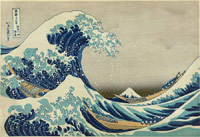One of the highest honors for an artist is to be considered and regarded a master. Artists desire to create artwork that will be remembered forever. The following are some of the most famous paintings of all time, easily recognized by people from all around the world.
Most famous paintings of all time in chronological order
Italian Renaissance Paintings
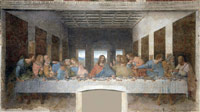 |
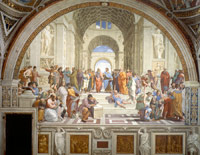 |
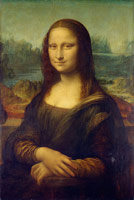 |
| The Last Supper, 1495-1498 By: Leonardo da Vinci A fifteenth century mural painting done in Milan by da Vinci, The Last Supper depicts the final feast Jesus had with his Twelve Apostles during which he announces one of them would betray him. |
School of Athens, c. 1510 By: Raphael The School of Athens (or Scuola di Atene in Italian) was one of Raphael’s commissions in the Stanze di Raffaello in the Vatican. The School of Athens is considered Raphael’s master artwork and is considered the perfect example of High Renaissance art. |
Mona Lisa, c. 1503-1519 By: Leonardo da Vinci This painting depicts Lisa del Giocondo whose expression is well-known for the enigmatic aura emanating from it. The Mona Lisa is possibly the most famous painting in the world of all time. |
Baroque Paintings
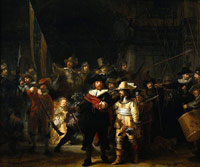 |
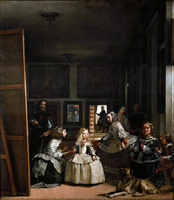 |
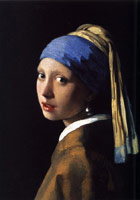 |
| The Night Watch (De Nachtwacht), 1642 By: Rembrandt van Rijn Rembrandt’s painting of a city guard led by Captain Frans Banning Cocq moving out is famous for three reasons: its large size of 11’10” x 14’4”, effective utilization of chiaroscuro (light and shadow balance), and its portrayal of motion in what would have been a traditionally static painting. Rembrandt completed the piece at the height of the Dutch Golden Age. |
Las Meninas, 1656 By: Diego Velazquez Las Meninas, or The Maids of Honor, depicts a room in the Madrid palace of Spain’s King Philip IV. The painting is famous for its complexities regarding reality and illusion. Uncertainty is played out in the relations between the viewers and the figures, as well as between the figures themselves. These complex uncertainties have welcomed much discussion and analysis among critics and scholars. |
Girl with a Pearl Earring, c. 1665 By: Johannes Vermeer One of Vermeer’s masterpieces, this painting utilizes a pearl earring as a focal point. It is sometimes known as “the Dutch Mona Lisa” or “the Mona Lisa of the North.” |
19th Century Paintings
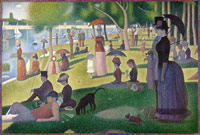 |
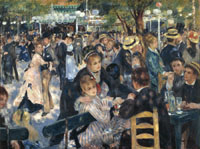 |
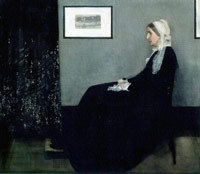 |
| A Sunday Afternoon on the Island of La Grande Jatte, 1884-1886 By: Georges Seurat One of Seurat’s most famous works, A Sunday Afternoon on the Island of La Grande Jatte features extensive use of a technique known as pointillism which consists of contrasted color dots that form a single hue through viewers’ eyes. Seurat spent over two years on this piece. He would practice his form repeatedly at the park, concentrating on the use of colors, form, and lighting. |
Bal du moulin de la Galette, 1886 By: Pierre-Auguste Renoir The 19th century painting by Renoir portrays working class people dressed up and enjoying a Sunday afternoon at the Moulin de la Galette in Paris. |
Whistler’s Mother, 1871 By: James McNeill Whistler Whistler painted his mother, Anna McNeill Whistler, when the original model failed to come to the appointment. The painting was not well-received when he submitted it to the Royal Academy of Art in London for exhibition, but shortly later the public showed much respect and deference for it, quickly restoring Whistler’s honor. |
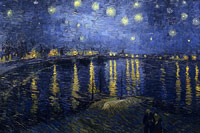 |
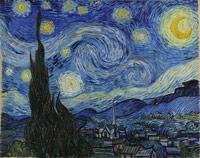 |
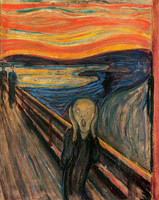 |
| Starry Night over the Rhone, c.1888 By: Vincent van Gogh One of van Gogh’s paintings of Arles at a riverbank not far from the Yellow House he was residing at the time. The night scenery, lighting, and stars provided subjects for his more famous paintings, such as The Starry Night. |
The Starry Night, 1889 By: Vincent van Gogh Considered to be the best and most famous work of Vincent van Gogh, The Starry Night was created from memory and portrays the sight outside the window of his sanitarium room at night. |
The Scream, 1893 By: Edvard Munch In a series of paintings reproduced with various media known as Scream, Edvard Munch conveys an extremely anxious and trembling person standing at the fenced edge of a road. The scene was identified as the view from a road overlooking Oslo, Norway. |
20th Century Paintings
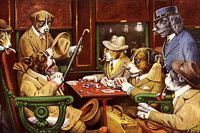 |
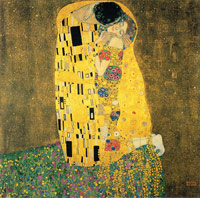 |
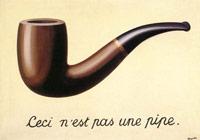 |
| Dogs Playing Poker, 1903 By: C.M. Coolidge Dogs Playing Poker is the collective name of sixteen oil paintings by C.M. Coolidge. Each painting was commissioned to advertise cigars for Brown & Bigelow. |
The Kiss, 1908 By: Gustav Klimt The Kiss, or Der Kuss, was Gustav Klimt’s most renowned art piece. He was done during the peak of his “Golden Period.” The Kiss depicts a man and woman kissing and embracing, with their bodies cloaked by elegant golden robes. Along with oil paint, gold leaf was used. His use of gold was influenced by a trip to Italy in 1903, after which gold and silver were used often in his art. |
La Trahison des Images (Ceci N’est pas une Pipe), 1928-29 By: Rene Magritte La Trahison des Images, or The Treachery of Images, was painted by Magritte in 1928-1929. Below is written: Ceci N’est pas une Pipe, meaning “this is not a pipe” in French. Magritte was trying to make the point that the painting was not an actual pipe, only a representation of one. |
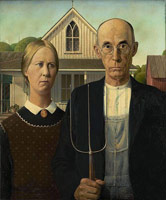 |
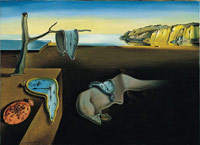 |
 |
| American Gothic, 1930 By: Grant Wood American Gothic was inspired by the Dibble House in Iowa. Wood saw its Gothic architectural style and decided to paint the house along with the kind of people he imagined might live in it. The painting depicts a farmer and his daughter, both modeled by his dentist and his sister. Each element of the painting was done separately; the models sat separately and were never at the house. |
The Persistence of Memory, 1931 By: Salvador Dali A widely known surrealist piece often referenced in pop culture. The Persistence of Memory depicts melting watches at a beach scene. Dali mentions that he was motivated by a surrealist concept of Camembert cheese melting under the sun. |
Guernica, 1937 By: Pablo Picasso Pablo Picasso’s detest of the Spanish Civil War is manifested in an art piece known as Guernica. The piece was commissioned by the Spanish Republican government to portray the pain and suffering caused by wars. Guernica would become a monumental symbol of anti-war and peace. |
 |
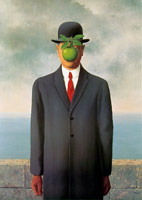 |
|
| No. 5, 1948, 1948 By: Jackson Pollock No. 5, 1948 was done on an 8 feet by 4 feet sheet of fiberboard, splattered with brown and yellow paint to give a nest-like appearance. The painting is supposedly abstract; the exquisiteness of how such a painting became so famous would most likely be misunderstood by many people. |
The Son of Man, 1964 By: Rene Magritte Magritte painted The Son of Man, or Le fils de l’homme, as a self-portrait. The painting depicts a man in a suit with a bowler hat; his face is mostly obscured by a green apple. The theme of the art work is a conflict between that which is visible and that which is hidden. The parts of a person we want to see is often obscured by what is visible. |
Famous Asian Paintings
